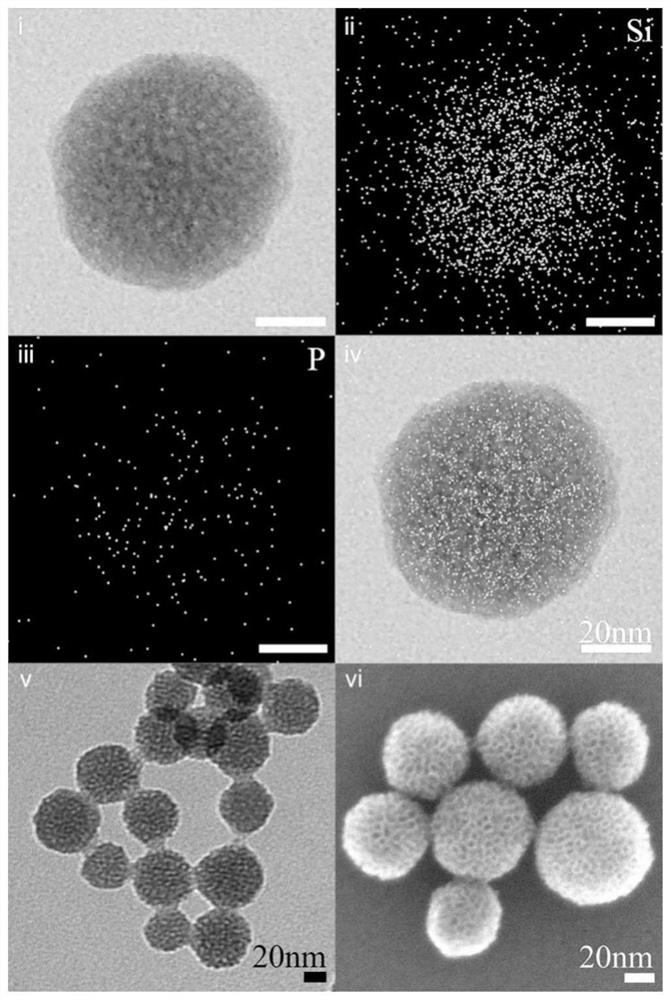Nano-drug for treating osteoporosis as well as preparation method and application of nano-drug
A technology for osteoporosis and nano-drugs, applied in nano-drugs, drug combinations, drug delivery, etc., can solve the problem of reducing the rapid blood clearance rate of NDDS and achieve good dispersion performance
- Summary
- Abstract
- Description
- Claims
- Application Information
AI Technical Summary
Problems solved by technology
Method used
Image
Examples
Embodiment 1
[0050] Example 1. Preparation method of mesoporous silica nano-medicine with deliberate targeting of bone tissue and therapeutic efficacy of osteoporosis
[0051] Including the following steps:
[0052] 1) After mixing 48ml of 25% cetyltrimethylammonium chloride (CTAC) solution with 72ml of deionized water, add 0.36g of triethanolamine (TEA) as a catalyst, under 60 ℃ oil bath heating condition Maintain for one hour, wait for the CTAC micelles to self-assemble into a template; mix tetraethyl orthosilicate (TEOS) into cyclohexane at a ratio of 20% (v / v), use a latex dropper to draw 20ml and add the above CTAC and TEA Among the reactants, an upper layer oil phase solution and a lower layer water phase solution are formed. After continuous stirring at a low speed for three hours under the condition of 60°C oil bath heating, the aqueous layer solution will gradually turn into light milky white. After using a separatory funnel to obtain the aqueous phase liquid, filter out the imp...
Embodiment 2
[0059] Embodiment 2, DNAM protection Aptscl56 experiment
[0060] Configuration concentration is the PBS solution of the DNA degrading enzyme I of 50ug / ml, add the free Aptscl56 of 500nmol and the DNAM containing 500nmol Aptscl56 respectively, observe the degradation situation of Aptscl56 by the method of DNA level electrophoresis at 0.25, 0.5, 2 and 24 hours respectively, The result is as figure 2 as shown ( figure 2 ). From figure 2 It can be seen that DNAM can well protect its surface Aptscl56 from being destroyed. In contrast, free Aptscl56 was rapidly degraded by DNA-degrading enzyme I and was almost completely degraded at 24 hours.
Embodiment 3
[0061] Embodiment 3, animal experiment 1
[0062] 20 nmol of free cy3-Aptscl56 (provided by Suzhou Beixin Biotechnology Co., Ltd.), 400 μg carrier PEGM and 400 μg nanomedicine DNAM modified by cy3-fluorescence at the 5’ end were injected into healthy mice through the tail vein. Each 100 μg of DNAM surface contained 5 nmol of Aptscl56 molecules. The experimental animals were sacrificed 1 hour, 12 hours, 1 day and 7 days after the injection, and the heart, liver, spleen, lung, bilateral kidneys, femur and tibia were collected, and the above specimens were scanned, qualitatively and qualitatively analyzed using a living fluorescence scanner. Quantitative analysis, see the results image 3 . Such as image 3 As shown in the histogram, DNA aptamers can specifically attach DNAM to the surface of bone matrix, and compared with free DNA aptamers and PEGM, its attachment time is longer, which can achieve long-term therapeutic effects.
PUM
| Property | Measurement | Unit |
|---|---|---|
| particle diameter | aaaaa | aaaaa |
Abstract
Description
Claims
Application Information
 Login to View More
Login to View More - R&D
- Intellectual Property
- Life Sciences
- Materials
- Tech Scout
- Unparalleled Data Quality
- Higher Quality Content
- 60% Fewer Hallucinations
Browse by: Latest US Patents, China's latest patents, Technical Efficacy Thesaurus, Application Domain, Technology Topic, Popular Technical Reports.
© 2025 PatSnap. All rights reserved.Legal|Privacy policy|Modern Slavery Act Transparency Statement|Sitemap|About US| Contact US: help@patsnap.com



